In a recent study published in Emerging Infectious Diseases, researchers investigated the stability of the Mpox virus in various surroundings and bodily fluids and the efficacy of decontamination methods.
 Study: Stability of Monkeypox Virus in Body Fluids and Wastewater. Image Credit: QINQIE99/Shutterstock.com
Study: Stability of Monkeypox Virus in Body Fluids and Wastewater. Image Credit: QINQIE99/Shutterstock.com
Background
Monkeypox is a zoonotic illness that spreads mainly through bodily fluids or intimate contact during sexual activity. The virus has been discovered in various samples, including saliva, blood, skin, feces, urine, and semen.
Transmission is more probable by direct contact or fomites, with most cases reported among males who have sex with male (MSM) individuals. Live Mpox virus has been detected in environmental samples, raising concerns regarding infection risk.
About the study
In the present study, researchers assessed the stability of the Mpox virus clade II MA001 strain on surfaces, bodily fluids, and wastewater, which was detected in May of 2022 in a human from Massachusetts, United States (US). They also evaluated the efficacy of chlorination-based decontamination approaches.
The experiments were performed under maximal containment circumstances with UV-B and UV-C protection using African green monkey (VeroE6) cells and 4.8 x 106 plaque-forming units (PFU) per mL of MA001. Wastewater specimens were obtained and held at -80°C from a municipal treatment plant in North Indiana.
MA001 surface stability was tested on cotton, polypropylene (15 mm), and stainless-steel disks (AISI 316L alloy) in temperate (4.0°C, 40% relative humidity), tropical (28°C, 65% relative humidity), and controlled (21°C to 23°C, 40% relative humidity) settings.
MA001 was spiked into sperm, blood, saliva, serum, feces, and urine to test its stability in bodily fluids. The team diluted 50 liters of stock Mpox virus in five mL of wastewater (which was irradiated with five millirads for potential pollutant inactivation) and deionized water at 1:100 concentration in triplicate to examine Mpox virus stability in wastewater and deionized water.
The researchers diluted the stock Mpox viral organism in wastewater 100 times to investigate the efficiency of free chlorine for cleaning MPXV in sewage. The viral stability was assessed at one-day, three-day, five-day, seven-day, 10-day, 15-day, and 20-day intervals.
Plaque assays were performed to quantify the Mpox virus; the detection limit for all replicates was 2.0 PFU/mL. For the wet and dry phases, the posterior median predicted half-lives (T1/2) were determined.
Results
A biphasic trend of slow degradation followed by fast degradation on surfaces for the Mpox virus. Since the shift in decay rate often happened after complete evaporation of liquid from surfaces, as observed for severe acute respiratory syndrome coronavirus 2 (SARS-CoV-2), those times were referred to as the wet and dry stages.
The Mpox virus degraded more quickly at elevated temperatures, and the pace varied greatly depending on the medium in which the virus was suspended, in solution, and on surfaces.
The Mpox virus showed higher stability on polypropylene and stainless-steel surfaces compared to on cotton, albeit retrieving a viable viral organism from an absorbent and porous surface such as cotton may vary from recovering a viable virus from a nonporous, nonabsorbent surface like stainless steel. More proteinaceous fluids accompanied greater persistence.
Only at greater doses was chlorination an effective decontamination procedure. In cases where large quantities of viral deoxyribonucleic acid (DNA) are identified in wastewater, testing for infectious Mpox virus might be a useful complement to polymerase chain reaction (PCR)-based wastewater surveillance.
The half-life of the virus could not be measured on cotton in the dry stage at ambient and tropical temperatures since no live virus was detected after macroscopically observable surface drying.
The T1/2 values in blood and semen showed no discernible variations between dry and wet stages; half-lives in these stages were comparable to those in solution. In contrast, viral half-lives on surfaces were much longer in the wet stage than in the dry stage for saliva, urine, and feces, while half-lives in solution were similar for all three secretions.
In blood, the half-life of the Mpox virus in the wet (solution) stage was 59 days, and the dry (surfaces) stage was 39 days. In semen, the half-life of the virus in both stages was five days.
In serum, the viral concentration decreased with time but had extended T1/2 values of more than 1.0 days. In serum, the T1/2 values for the virus on surfaces and in solution were 1.3 days and two days, respectively.
In saliva, the T1/2 values in the wet and dry stages were 6.5 days and 2.1 days, respectively. The Mpox virus showed lower stability in feces and urine, but degradation increased on surfaces as in other bodily fluids. The T1/2 values for urine on surfaces and in solution were 0.1 days and 1.7 days, respectively. The corresponding T1/2 values for feces were 0.1 days and 1.3 days, respectively.
Implications
The study findings showed that parameters such as the virus's surface, ambient circumstances, and viral matrix affect Mpox virus stability. The Mpox virus remained stable in bulk liquid conditions and on surfaces, particularly wet surfaces.
Mpox virus stability increased as the serum percentage rose. The Mpox virus did not decay in untreated deionized water during the measurement period but to a relevant level in wastewater.
To rapidly inactivate polluted wastewater samples, higher chlorine concentrations are necessary. Mpox virus persistence in the environment highlights the importance of avoiding nosocomial and environmental transmission.
The discovery that the Mpox virus may survive in untreated wastewater for weeks increases the risk of infection among sanitation personnel, peridomestic animals, and wildlife. However, dilution and chemical disinfection can reduce the hazards.